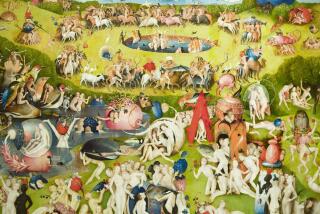BOOK REVIEW : Into the Soul of the Animal Connection : DIVORCE AMONG THE GULLS, An Uncommon Look at Human Nature<i> by William Jordan</i> North Point Press $17.95, 212 pages
- Share via
In his fine collection of essays, “Divorce Among the Gulls,” William Jordan worries about our collective fate through a series of very personal ruminations about the natural world.
He finds parallels with human domesticity in the lives of gulls and mocking-birds; he finds inspiration in the habits of cockroaches and Medflies (he is by profession an entomologist).
The essays in the first part of this volume have a whimsical tone. Wedding guests pause in the moonlight when a potato-sized roof rat dashing along a power line is silhouetted by the moon. While the bride’s father fumes, the author mutters, “What a wonderful thing!”
As a biologist, Jordan sees the infamous plague-bearing rodent as “a masterpiece of evolution, a living thing which had been genetically calibrated to thrive in the nest of its most formidable enemy, the self-anointed pinnacle of evolution, Homo sapiens. “
Much is known about roof rats, thanks to recent research fitting them with tiny radio transmitters. “The fact is, a neighborhood is an ecosystem,” Jordan writes, a place of natural laws where each organism has a niche. Rats thrive among humans because they have adapted to be small, colorless so as to fade into the shadows and delighted to eat what we eat, from peanut butter to avocadoes and apricots.
About the Medfly Jordan waxes lyrical. He describes how females choose males who are both tough and tender. Female Medflies have sought such males for millions of years, Jordan extrapolates, “so that the traits of the tender macho have been incorporated in his genes. I suspect that such qualities have also been encoded in the genes of many human males, needing only to be encouraged by female choice in order to develop.”
In “Cockroach Memoirs,” we learn that although the insect brain may be laid out differently from our own, the structures are the same.
“In other words, the human mind is an extension of the animal mind--a variation on a theme--not a celestial novelty.” Evolution is remarkable but not perfect; it is “a cheapskate,” using “nothing but used parts.” That is, “new species are always created out of old; nothing is ever conjured, full blown, from new materials.”
The subject of evolution’s short-comings brings Jordan to muse about the tuna, “probably the most sophisticated fish in the sea . . . a masterpiece of hydrodynamic design, its shape ideal for high speeds.” It can zip along at 55 m.p.h. But the poor tuna pays a price, for it can only perform this way because it is warm-blooded, and because it is warm-blooded it must maintain its speed to warm its blood. If it slows down, it dies.
The second part of the book describes the pleasure and pain of Jordan’s scientific education. He begins with a vivid evocation of the day he set up his Ph.D research experiment in the corner of a field near Salinas. Deep among the alfalfa stalks, he finds himself in a parallel universe filled with spittle bugs encased in pods of foam, buffalo treehoppers and “green inchworms that measure as they walk,” as well as the subject of his research, the alfalfa wasp. As the day ends, the young biologist has become a naturalist.
In the concluding essays, Jordan is highly critical of laboratory work (as opposed to work in the field), and especially of the callous use of animals. His nightmarish experiences are not anomalies, he claims, but a deliberate coarsening to distance scientists from feelings in order to acquire “a scientific system of values.”
At fault, he claims, is our very thought process. “I am convinced that one of the main functions of the rational mind is to deceive itself. . . . Homo sapiens is not a rational animal; it is a rationalizing one.” Humans reason in their own interests, according to Jordan, and commit moral atrocities in the name of progress.
What to do about our species’ inclination to commit technological mayhem in the name of reason?
Jordan acknowledges that humans cannot refrain from doing research, from indulging that curiosity that is part of our self-definition. But he points out that Japanese pharmaceutical companies have altars where researchers thank and apologize to the animals they are about to sacrifice.
Jordan would have Americans do as much. He suggests in the final essay that students be taught the “intimate kinship of all life on earth.” Like the Japanese, he urges, they should express thanks to every creature in the laboratory: “Say a small prayer for its soul. Say a small prayer for the souls of us all.”
Next: Jonathan Kirsch reviews “Road Fever: A High-Speed Travelogue” by Tim Cahill (Random House).
More to Read
Sign up for our Book Club newsletter
Get the latest news, events and more from the Los Angeles Times Book Club, and help us get L.A. reading and talking.
You may occasionally receive promotional content from the Los Angeles Times.








